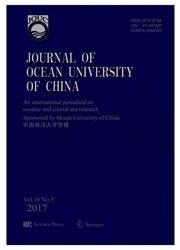

 中文摘要:
中文摘要:
Fe-Si-Mn-oxyhydroxide encrustations at the East Pacific Rise(EPR) near 13°N were analyzed using the scanning electron microscope(SEM) with an energy dispersive spectrometer(EDS). These encrustations are mainly composed of amorphous FeSi-Mn-oxyhydroxides forming laminated, spherical, porous aggregates with some biodetritus, anhydrite, nontronite, and feldspar particles. Anhydrite particles and nontronite crystals in the Fe-Si-Mn-oxyhydroxide encrustations imply that the Fe-Si-Mn- oxyhydroxide may have formed under relatively low- to high-temperature hydrothermal conditions. The Fe-Si-Mn-oxyhydroxide encrustations on pillow basalts are 1–2 mm thick. The growth rate of ferromanganese crusts in the survey area suggests that these encrustations are an unlikely result of hydrogenic deposition alone having a hydrothermal and(Fe/Mn ratio up to 7.7 and Fe/(Fe+Mn+Al) ratio exceeding 0.78) hydrogenic origin(0.22 Fe/Mn ratio close to the mean value of 0.7 for open-ocean seamount crusts). The varying Fe/Mn ratios indicate that the Fe-Si-Mn-oxyhydroxide encrustations have formed through several stages of seafloor hydrothermalism. It is suggested that, at the initial formation stage, dense Fe-Si-oxyhydroxides with low Mn content deposit from a relatively reducing hydrothermal fluid, and then the loose Fe-Si-Mn-oxyhydroxides deposit on the Fe-Si-oxyhydroxides. As the oxidation degree of hydrothermal fluid increases and Si-oxide is inhibited, Mn-oxide will precipitate with Fe-oxyhydroxides.
 英文摘要:
英文摘要:
Fe-Si-Mn-oxyhydroxide encrustations at the East Pacific Rise (EPR) near 13°N were analyzed using the scanning electron microscope (SEM) with an energy dispersive spectrometer (EDS). These encrustations are mainly composed of amorphous Fe- Si-Mn-oxyhydroxides forming laminated, spherical, porous aggregates with some biodetritus, anhydrite, nontronite, and feldspar particles. Anhydrite particles and nontronite crystals in the Fe-Si-Mn-oxyhydroxide encrustations imply that the Fe-Si-Mn-oxyhy- droxide may have formed under relatively low- to high-temperature hydrothermal conditions. The Fe-Si-Mn-oxyhydroxide encrusta- tions on pillow basalts are 1-2mm thick. The growth rate of ferromanganese crusts in the survey area suggests that these encrusta- tions are an unlikely result of hydrogenic deposition alone having a hydrothermal and (Fe/Mn ratio up to 7.7 and Fe/(Fe+Mn+A1) ratio exceeding 0.78) hydrogenic origin (0.22 Fe/Mn ratio close to the mean value of 0.7 for open-ocean seamount crusts). The varying Fe/Mn ratios indicate that the Fe-Si-Mn-oxyhydroxide encrustations have formed through several stages of seafloor hydrother- malism. It is suggested that, at the initial formation stage, dense Fe-Si-oxyhydroxides with low Mn content deposit from a relatively reducing hydrothermal fluid, and then the loose Fe-Si-Mn-oxyhydroxides deposit on the Fe-Si-oxyhydroxides. As the oxidation degree of hydrothermal fluid increases and Si-oxide is inhibited, Mn-oxide will precipitate with Fe-oxyhydroxides.
 同期刊论文项目
同期刊论文项目
 同项目期刊论文
同项目期刊论文
 Formation of Fe-Si-Mn oxyhydroxides at the PACMANUS hydrothermal field, Eastern Manus Basin: Mineral
Formation of Fe-Si-Mn oxyhydroxides at the PACMANUS hydrothermal field, Eastern Manus Basin: Mineral The contribution of trace elements from seawater to chimneys: a case study of the native sulfur chim
The contribution of trace elements from seawater to chimneys: a case study of the native sulfur chim Elemental and isotopic compositions of the hydrothermal sulfide on the East Pacific Rise near 13 deg
Elemental and isotopic compositions of the hydrothermal sulfide on the East Pacific Rise near 13 deg Genesis of (230)Th excess in basalts from mid-ocean ridges and ocean islands: Constraints from the g
Genesis of (230)Th excess in basalts from mid-ocean ridges and ocean islands: Constraints from the g Geochemical and isotopic characteristics of volcanic rocks from the northern East China Sea shelf ma
Geochemical and isotopic characteristics of volcanic rocks from the northern East China Sea shelf ma Generation and evolution of magma beneath the East Pacific Rise: Constraints from U-series disequili
Generation and evolution of magma beneath the East Pacific Rise: Constraints from U-series disequili Origin of native sulfur ball from the Kueishantao hydrothermal field offshore northeast Taiwan: Evid
Origin of native sulfur ball from the Kueishantao hydrothermal field offshore northeast Taiwan: Evid Element enrichment and U-series isotopic characteristics of the hydrothermal sulfides at Jade site i
Element enrichment and U-series isotopic characteristics of the hydrothermal sulfides at Jade site i Trace element composition of peridotites from the southern Mariana forearc: Insights into the geoche
Trace element composition of peridotites from the southern Mariana forearc: Insights into the geoche 期刊信息
期刊信息
